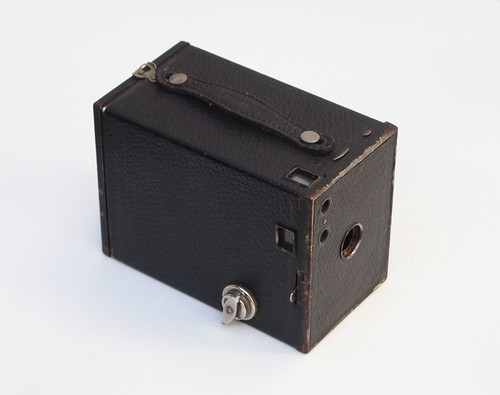 |
| Kodak No.2 Brownie |
"Simple, sturdy, reliable, these inexpensive little cameras have stood the test of years, and will be found in the hands of many thousands of people all over the world, who are making perfectly satisfactory pictures with them. They are especial favorites with the children on account of their great simplicity, but they are withal so practical that they have been readily taken up by grown-up people who wish to make pictures in the easiest possible manner and at the minimum of expense. Each has two finders, automatic shutter, carefully tested lens, and imitation leather covering. They [the Brownie No.2 and No.2A] differ from each other only in the size of the pictures they make and in their lenses."
Building on the premise of the first Kodak camera of 1888, the original Brownie was designed by Frank Brownell for Eastman Kodak to sell for just one dollar (the original Kodak was first priced at $25; at the time the Brownie appeared, a pocket Kodak was $5). This price reduction was achieved by a number of design and manufacturing processes, but chiefly by substituting the well constructed wooden body of the first Kodaks with leather covered cardboard for the Brownie. The original Brownie of 1900 was designated the No.1 once the No.2 was produced a year later. Like the original Kodak, it had no viewfinder, but V-shaped sightlines incised on the body to aid framing. A few months later an accessory finder was provided which the user could attach to the camera body; the No.2 Brownie had two integral finders for portrait and landscape orientation. The No.2 was originally priced at $2, quite possibly due to the inclusion of those two viewfinders. The significance of the No.2 Brownie of 1901 is due to Eastman Kodak introducing a paper-backed rollfilm format still widely used today: 120. The 120 format provides negatives of approximately 6x9cm; as prints were commonly made by contact at the time, a large negative was an advantage. During their first half century of camera manufacture, Kodak produced numerous film formats. Retrospectively assigned number codes in 1912, beginning sequentially from 100, there were 20 different formats by the time the Brownie No.2 appeared 1901. Although a number of the competing formats were continued for many years, for some reason, the c.62mm-wide paper-backed rollfilm of the No.2 Brownie emerged as the standard.Kodaks and Kodak Supplies / 1914 (Canadian Kodak Company)
I've had two No.2 Brownie cameras, the first came from a car boot sale nearly twenty years ago priced £1, the second bought recently was £3 (unless in exceptional condition or a rare variant, Brownie cameras should not be expensive today, as some models had production runs in the millions). Illustrated here, I bought this second camera to create a film splitter, but after cleaning it and gluing down some of the leatherette, the camera seemed too good not to use . Both my No.2 Brownie cameras were the Model F, made from 1924 onwards. The significant change introduced with the Model F was that the card body was now made in metal. Additionally, two tripod sockets were added. According to the Brownie Camera site, my current Brownie camera can be identified by its fully detachable rear door as an early version from 1924-25.
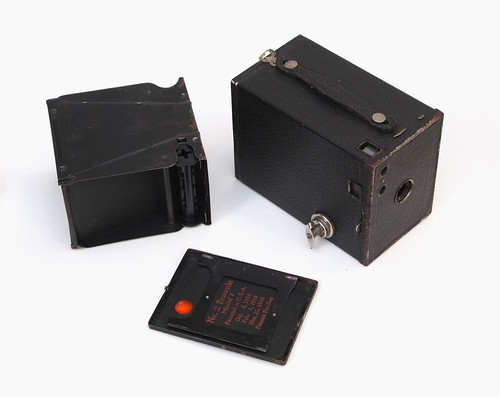 |
| Kodak No.2 Brownie, with film carrier removed |
 |
| Kodak No.2 Brownie sector shutter |
"To take instantaneous pictures the object should be in the broad open sunlight, but the camera should not. The sun should be behind the back or over the shoulder of the operator. Snap shots should only be made when the largest stop is before the lens. If a smaller stop be used, the light will be so much reduced that it will not sufficiently impress the image on the film and failure will result. [...]
STOPS. The stops should be used as follows:When introduced most films were either 'ordinary', that is, blue sensitive, or orthochromatic, and developed by inspection, and although Picture Taking with the Brownie Camera No. 2 describes using a 'Brownie Developing Box' or a film tank, it does also have a section on tray developing film. Developing by inspection would allow for compensation in under- (or over-) exposure with extending or contracting development time. Additionally, from reading photography books such as the Ilford Manual of Photography, I have the impression that the intensification and reduction of negatives was common, something I've never done, but Picture Taking with the Brownie Camera No. 2 does mention these techniques. Occasionally I have read opinions online that modern fast films are too fast for box cameras, designed as they were for the use of slow films, with slow shutter speeds to match. I have never found this to be the case. Most modern films have enough latitude to provide good results in a variety of lighting conditions with a box camera that has very limited exposure controls. With a fast film in the No.2 Brownie, the smallest stop can be used for instantaneous exposures in bright light, but, unless taking photographs in bright sunlight, the middle stop usually gives the best results (it is also possible that using the smallest stop may actually reduce image quality due to diffraction). Incidentally, I have been recently testing Agfa Superpan 200, and shot one roll in the No.2 Brownie; at 200 ISO, the speed of the film is a good match for instantaneous exposures and the film's sharpness and relatively high contrast appear to be excellent qualities to offset the softness of the Brownie's lens.
1. THE LARGEST For all ordinary instantaneous exposures.
2. THE MIDDLE For instantaneous exposures when the sunlight is unusually strong and there are no heavy shadows; such as in views on the sea shore, or on the water; also for interior time exposures, the time for which is given in the table on pages 16 and 17.
3. THE SMALLEST For time exposures out doors in cloudy weather. Not for instantaneous exposures. The time required for time exposures on cloudy days with smallest stop will range from one-half second to five seconds, according to the light. The smaller the stop the sharper the picture. When setting the stops always see that the one to be used is brought to the center of the lens, where it catches. If you use the smallest stop for instantaneous exposures absolute failure will result."
My first No.2 Brownie was my second medium format camera, my first being a Zeiss Ikon Ikoflex. Unlike the Ikoflex which had double-exposure prevention and an automatic film counter, I realised that advancing the film by using the red window in the Brownie, I could create overlapping exposures. I subsequently made a series of in-camera panoramic triptychs by rotating the camera on a tripod and advancing the film between each shot so that the exposures would just overlap and join together, creating an image spanning roughly 135 degrees. It would be possible to make a longer image with more exposures, but three overlapping shots are nearly ten inches wide, and as such fitted onto a sheet of 10x8-inch paper for contact prints, and this could also be enlarged using the large format 10x8 Durst enlarger that I had access to at college.
 |
| In-camera panoramic shot on Ilford HP5 Plus |
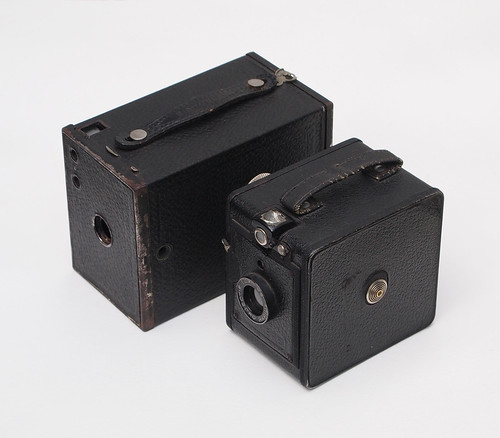 |
| The Kodak No.2 Brownie with (front) the Lumière Scout Box |
 |
| Kodak No.2 Brownie with Rollei RPX400 |
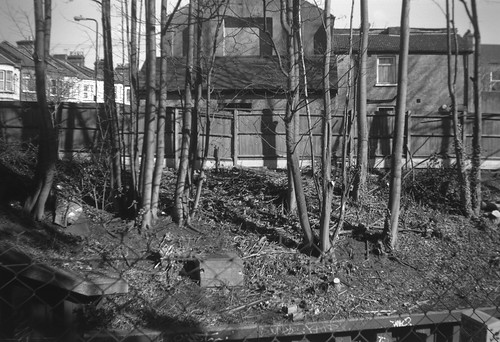 |
| Kodak No.2 Brownie with Agfa Superpan 200 |
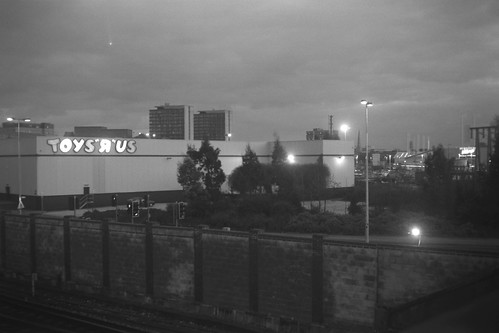 |
| Kodak No.2 Brownie with Ilford HP5 Plus |
Kodaks and Kodak Supplies 1914, Canadian Kodak Co. Ltd
Picture Taking with the Brownie Camera No. 2, Canadian Kodak Co. Ltd, 1918
The early years of Eastman Kodak on Kodak.com
The No.2 Brownie on the Brownie Camera Page
No.2 Brownie on Early Photography
History of Kodak Cameras with film sizes, original prices and production dates
B is for Brownie at the National Media Museum
George Eastman House collection of Brownies
What a wonderful review of this seminal camera! I have a No. 2 Brownie Model D, and I adore it. My favorite film to shoot in it is Ektar 100. The colors are outstanding, the center sharpness is astonishing, and the corner softness is otherworldly. I'm not often charmed by such a simple machine but I certainly am by this one.
ReplyDelete